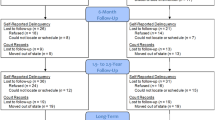Abstract
Placement instability is a pervasive and long-standing problem which adversely affects outcomes for many young people in foster care. The Special Youth Carer(SYC) program, developed in South Australia in response to the needs of at-risk adolescents, is an innovative model aimed at reducing placement instability and promoting positive behavior change. Based primarily upon the Treatment Foster Care (TFC) model, SYC incorporates an additional defining feature: in the event of a placement breakdown, it is the carer and not the young person who leaves the home. This report includes a description of the program, an overview of outcomes for eight of the first program participants who were monitored over a 12-month period, and interviews with two carers who experienced the breakdown of an SYC placement. Positive behavioral change was reported for most participants, and there were some noteworthy improvements in placement stability.
Similar content being viewed by others
References
Australian Institute of Health and Welfare. (2003).Child Protection Australia 2002--2003. Retrieved April 26, 2004, from http://www.aihw.gov.au/publications/ index.cfm?type=detail&id=9771
T. Baldwin B. Durkin R. Nicholls (2001) “It’s made a big difference!” A Best Practice study of the Lead Tenant Model Wesley Mission Melbourne Melbourne
J. G. Barber P.H. Delfabbro L. L. Cooper (2001) ArticleTitleThe predictors of unsuccessful transition to foster care Journal of Child Psychiatry 42 785–790
Bath, H. (2001). The role and future of residential care in out-of-home care. ‘Finding a Place’ Forum, Community Services Commission and Association of Children’s Welfare Agencies, October 2001. Retrieved October 2, 2003, from www.acwa.asn.au/acwa/news/ResCareFuture.doc.
D. Berridge H. Cleaver (1987) Foster Home Breakdown Basil Blackwell Oxford
Cashmore, J., & Paxman, M. (1996).Longitudinal Study of Wards Leaving Care. Retrieved 13 August 2001, from the World Wide Web: http://www.acwa.asn.au/LCSP/publications/excsum.htm
Community Services Commission (1996) The drift of children in care into the juvenile justice system—turning victims into criminals Author Sydney
CREATE Foundation. (2003).Submission to the Crime and Misconduct Commission Inquiry into Foster Care.Retrieved October 23, 2003, from http://www.cmc.qld. gov.au/library/CMCWEBSITE/FCI_Sub_Create.pdf
M. De Lemos (1997) Educational needs of children in care report on a research study of children in residential and home-based care Australian Council for Educational Research Camberwell Victoria
D. Fanshel S. J. Finch J. F. Grundy (1989) ArticleTitleModes of exit from foster family care and adjustment at time of departure of children with unstable life histories Child Welfare 68 391–402
D. Fanshel S. J. Finch J. F. Grundy (1990) Foster children in a life course perspective Columbia University Press New York
E. M. Z. Farmer B. J. Burns M. S. Dubs S. Thompson (2002) ArticleTitleAssessing conformity to standards for treatment foster care Journal of Emotional and Behavioral Disorders 10 213–222
E. Fernandez (1999) ArticleTitlePathways in substitute care: Representation of placement careers of children using event history analysis Children and Youth Services Review 21 177–216 Occurrence Handle10.1016/S0190-7409(99)00014-6
R. Gilbertson J.G. Barber (2002) ArticleTitleObstacles to involving children and young people in foster care research Child and Family Social Work 7 253–258 Occurrence Handle10.1046/j.1365-2206.2002.00251.x
R. Gilbertson J. Barber (2004) ArticleTitleThe systematic abrogation of practice standards in foster care Australian Social Work 57 31–45 Occurrence Handle10.1111/j.0312-407X.2003.00112.x
M. Kalland J. Sinkonnen (2001) ArticleTitleFinnish children in foster care: Evaluating the breakdown of long-term placements Child Welfare 80 513–527
J. Lahti (1982) ArticleTitleA follow-up study of foster children in permanent placements Social Service Review 56 556–571 Occurrence Handle10.1086/644047
A. Maslow (1954) Motivation and personality Harper & Row New York
J. Phillips (1997) ArticleTitleMeeting the psychiatric needs of children in foster care Psychiatric Bulletin 21 609–611 Occurrence Handle10.1192/pb.21.10.609
K. Proch M. A. Taber (1987) ArticleTitleAlienated adolescents in foster care Social Work Research and Abstracts 23 9–13
L. A. Reddy S. I. Pfeiffer (1997) ArticleTitleEffectiveness of treatment foster care with children and adolescents: A review of outcome studies Journal of the American Academy of Child and Adolescent Psychiatry 36 581–588 Occurrence Handle10.1097/00004583-199705000-00007
J. Rowe M. Hundleby L. Garnett (1989) Child care now: A survey of placement patterns British Agencies for Fostering and Adoption London
Semple and Associates. (2002). Review of Alternative Care in South Australia.
D. K. Smith (2004) ArticleTitleRisk, reinforcement, retention in treatment, and reoffending for boys and girls in multidimensional treatment foster Care Journal of Emotional and Behavioral Disorders 12 38–48
D. K. Smith E. Stormshak P. Chamberlain R. B. Whaley (2001) ArticleTitlePlacement disruption in Treatment Foster Care Journal of Emotional and Behavioral Disorders 9 200–205 Occurrence Handle10.1177/106342660100900306
J. Strijker T. Zandberg B.F. van der Meulen (2002) ArticleTitleIndicators for placement in foster care British Journal of Social Work 32 217–231 Occurrence Handle10.1093/bjsw/32.2.217
Teather, E. C., Davidson, S.D, & Pecora, P. J. (1994).Placement disruption in family foster care. Retrieved, from the World Wide Web: Accessed on 2 February, 2002, from, http://www.casey.org/research/reports/pdisrup/pdisrup.html
J. Thoburn (1991) Survey findings and conclusions J. Fratter J. Rowe D. Sapsford J. Thoburn (Eds) Permanent family placement: A decade of experience BAAF London
Author information
Authors and Affiliations
Corresponding author
Rights and permissions
About this article
Cite this article
Gilbertson, R., Richardson, D. & Barber, J. The Special Youth Carer Program: An Innovative Program for At-Risk Adolescents in Foster Care. Child Youth Care Forum 34, 75–89 (2005). https://doi.org/10.1007/s10566-004-0883-7
Issue Date:
DOI: https://doi.org/10.1007/s10566-004-0883-7



